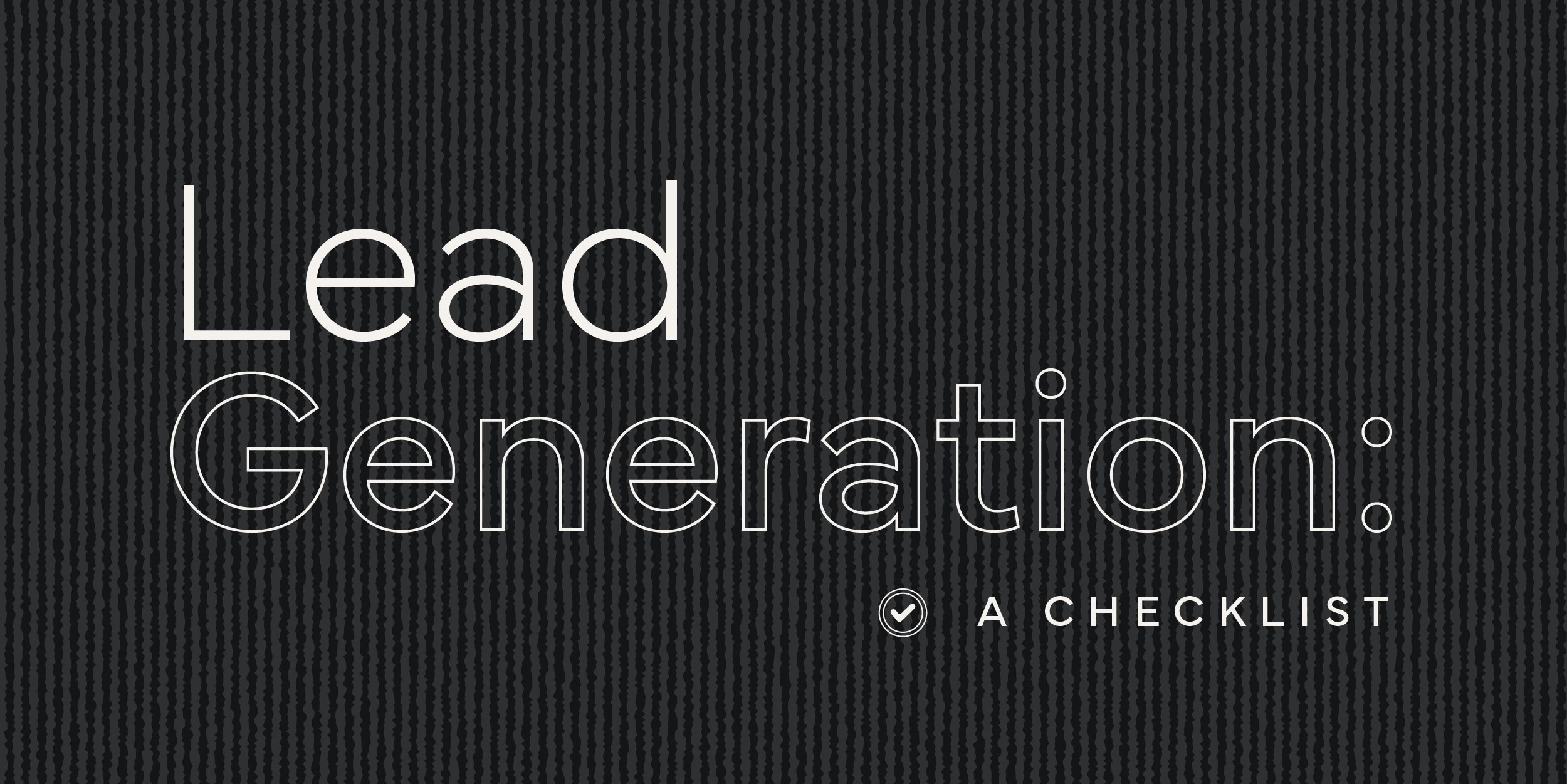BLOG Social Media’s Role in Lead Generation
Social Media’s Role in Lead Generation
POSTED BY Primitive | Aug 25, 2020

Marketing is so much more nuanced than just “brand awareness” and “engagement.”
Capturing qualified leads and filling your pipeline is one of the most critical needs for any business, and whether you know it or not, social media is a key piece to the puzzle.
So, how does your team go about getting more leads from social media? Let’s take a look.
Choosing your company’s platforms
Before you and your team go all-in on social advertising, do yourself a favor by really defining your buyer personas.
Once you’ve done your homework, you can then compare that information to the demographics of each social media platform to determine the best platforms to utilize.
Some of the platforms your team will most likely consider are:
- Facebook
- Statistics: In 2019, Facebook acquired 2.45 billion monthly active users (MAUs). Also, according to research performed by Social Media Today and Sharpspring, according to B2B marketers polled, 82% believe Facebook is the best platform for lead generation.
- Demographics : 75% male, 63% female (the study does not include data on non-binary individuals); 84% of Facebook users are 25-30 year olds.
- Instagram
- Statistics: 1 billion users utilize Instagram on a monthly basis, with half of those individuals using the social platform every day.
- Demographics: 43% female, 31% male (the study does not include data on non-binary individuals); 75% of Instagram users are 18-24 years old.
- LinkedIn
- Statistics: According to LinkedIn, 89% of B2B marketers use the social media platform for lead generation, with marketers also declaring LinkedIn generates 2x more leads than the next highest social media channel.
- Demographics: 24% female, 29% male (the study does not include data on non-binary individuals); 44% of LinkedIn users are 25-30 years old.
- YouTube
- Statistics: When speaking purely about mobile devices, YouTube reaches more 18-34 year old US audience members than any TV network.
- Demographics: 68% female, 78% male (the study does not include data on non-binary individuals); 93% of YouTube users are 25-30 years old.
- Twitter
- Statistics: In the first quarter of 2020, Twitter announced they had 144 million monetizable daily active users (mDAUs) which is a 24% year-over-year growth.
-
- Demographics: 21% female, 24% male (the study does not include data on non-binary individuals); 44% of Twitter users are 18-24 years old.
- Pinterest
- Statistics: Pinterest’s 2019 Q4 earnings report indicated a 26% increase in their active user base granting them 335 million users in 2019.
- Demographics: 42% female, 15% male (the study does not include data on non-binary individuals); 38% of Pinterest users are 18-24 years old.
Optimize your social media profile
Before you’re ready to launch your next campaign, you need to ensure your profile is primed to collect organic leads. So, let’s start with the basics.
- Name
- Your visitors should be able to easily identify your brand name
- Contact information
- Your brand should be ready and able to take customer inquiries (phone, email, Facebook Messenger, chatbot, etc). Make sure your company is ready for this influx of requests prior to providing your contact information on your profile.
- Link to website
- Many social media platforms are quickly rolling out tools to help small businesses. (You can view some examples here and here.) However, if your business site doesn’t have access (yet!) to the number of followers necessary for certain business tools (for example, Instagram’s “swipe up” feature), it then becomes increasingly important to make sure your account has a direct link to your website for visitors to access.
- Call-to-actions (CTAs)
- Depending on your business and the social platform, it can be vital to have prominent call-to-action buttons on display both on your business page or within your social captions.
For example, Facebook offers a “Book Now” button that can be featured on your business page to ensure a customer’s interest in your services results in an easily made appointment. You can also use captions to generate traffic to your website or landing pages by infusing micro (read: engagement) CTAs that lead to macro (read: gated content) asks, such as:
“What do you look for in a brand’s website? Let us know in the comments below, and don’t forget to download our free infographic Anatomy of a Great Website by following the link in our bio!”
Leverage digital advertising
Your brand’s message can travel much further with targeted, online, data-driven strategies that are capable of reaching your target audience within every stage of the buyer’s journey.
To further this point, let’s compare traditional advertising to digital advertising.
Traditional advertising can take the form of, for example, a billboard. While your business can hope the billboard finds your ideal market, there are absolutely zero guarantees the ad will reach your target audience.
Taking the example one step further, with many traditional marketing efforts, there’s no way to track the digital footprint of the ad to verify its efficacy, a.k.a. your marketing ROI.
Digital advertising, on the other hand, reaches the precise individuals your business seeks/ those who are actively seeking your products or services. Better yet, through your social media channels, your company can create relevant videos, images and text-based ads that appeal to your personas and their specific interests at a moment when they are ready to be reached.
But with so many varied types of social media platforms out there in existence, how does your organization decide which platforms might not generate as many leads as desired, and which platforms will really boost your digital marketing efforts?
Well, the answer is kind of simple.
The platform your customers use the most is where you want to focus your marketing dollars.
Have compelling and clickable content in your back pocket
If your site doesn’t have compelling content, you won’t generate the type of interest in your products that results in swoon-worthy conversion rates.
With practically everyone searching the internet these days, your social media is prime real estate to capture qualified leads. But, keep in mind your company is competing for the attention of millions of potential consumers, which means your social site needs to have eye-catching images and crisp, clear copy.
If you’ve found yourself able to capture your prospects’ attention, make sure you keep it by providing offers that are well worth an exchange of information.
Ensuring every post is compelling and clickable is the first step in a sound lead generation strategy, but always try to take it a step further by ensuring each post has a click-worthy CTA that takes the visitor to an offer.
A few excellent content offers to provide your visitors in exchange for information are:
- Discount codes
- Contest or sweepstakes entries
- Gated content (eBooks, infographics, invite-only events, private Facebook groups, etc)
Data is key! Don’t forget to collect it!
If you’ve done your due diligence with your social media pages, you’ve most likely been able to send prospects to a specific landing page that has more information relevant to their interests.
Now, it’s time to do your company a favor and track your data so you can see which platforms are generating the highest ROI on your marketing dollars.
One of our favorite ways to track this data is with Google Analytics.
Google Analytics can help track and report your website and social media traffic by providing you with a unique URL that can be added to your landing pages which will track leads on your landing pages. This helps identify where your audience is finding you and helps allocate your marketing dollars more effectively down the road. (For example, if you happen to notice your brand obtains more leads from Instagram than LinkedIn, you can double, or even triple-down, on your Instagram adspend.)
Facebook also recently released their own method of tracking critical metrics and insights aptly entitled Facebook Analytics. This tool helps identify and track visitors that find their way to your Facebook Business page so you can better understand their habits along with their customer journey.
Social media is a deeply integral element to any content marketer’s strategy. Valuable leads are ready to be generated and turned into conversions that add to growth and sustainability of your company.
Download our free eBook to learn more about how your business can optimize your lead generation strategy.
SHARE THIS POST:

About the writer, Primitive
The team behind On the Dot. is made up of creatives, strategists, and developers who give a damn. At Primitive, we craft digital solutions that help businesses grow from brand to backend. Every insight we share is backed by strategy, driven by results, and built to move your business forward.

